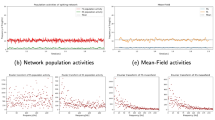Abstract
The features of the electromyogram (EMG) are studied using a population model of skeletal muscle based on the differing properties and the independent activation of motor units (MUs). It is shown, both analytically and by computer simulation, that: (a) The power spectrum of the EMG is determined by the distribution of filtering and firing properties of the active MUs. (b) A tendency towards a rhythmical grouping of action potentials is to be expected from a set of asynchronous MUs firing semiregularly at similar rates; the grouped electrical activity has a phase-lead over the force output of the set of about 180°. A unified explanation of the properties of the muscle force waveform and the electromyogram, in terms of asynchronous activity of MUs, is proposed. The explanation covers the relationship and the differences between the two signals.
Similar content being viewed by others
References
Agarwal, G.C., Gottlieb, G.L.: An analysis of the electromyogram by Fourier, simulation, and experimental techniques. IEEE Trans. Biomed. Eng. 22, 225–229 (1975)
Blinowska, A., Verroust, J., Cannet, G.: The determination of motor units characteristics from the low frequency electromyographic power spectra. Electromyogr. Clin. Neurophysiol. 19, 281–290 (1979)
Blinowska, A., Verroust, J., Cannet, G.: An analysis of synchronization and double discharge effects on low frequency electromyographic power spectra. Electromyogr. Clin. Neurophysiol. 20, 465–480 (1980)
Brody, G., Scott, R.N., Balasubramanian, R.: A model for myoelectric signal generation. Med. Biol. Eng. 12, 29–41 (1974)
Christakos, C.N.: A population stochastic model of skeletal muscle and its use in the study of the frequency characteristics of muscle output activity with particular reference to tremor. Ph.D thesis, University of London (1980)
Christakos, C.N.: Asynchronous motor unit activity: a common explanatory basis for the features of muscle force and myoelectric signal. Neurosci. Lett. 7, S102 (1981)
Christakos, C.N.: A linear stochastic model of the single motor unit. Biol. Cybern. (1982a) (in press)
Christakos, C.N.: A study of the muscle force waveform using a population stochastic model of skeletal muscle Biol. Cybern. (1982b) (in press)
Christakos, C.N., Lal, S.: Asynchronous motor unit activities and tremor. J. Physiol. (London) 293, 42–43P (1979)
Christakos, C.N., Lal, S.: Lumped and population stochastic models of skeletal muscle: implications and predictions. Biol. Cybern. 36, 73–85 (1980)
De Luca, C.J., Forrest, W.J.: Some properties of motor unit action potential trains recorded during constant force isometric contraction in man. Kybernetik 12, 160–168 (1973)
De Luca, C.J., Vandyk, E.J.: Derivation of some parameters of myoelectric signals recorded during sustained constant force isometric contractions. Biophys. J. 15, 1167–1180 (1975)
Elble, R.J., Randall, J.E.: Motor-unit activity responsible for 8 to 12 Hz component of human physiological finger tremor. J. Neurophysiol. 39, 370–383 (1976)
Fay, D.F., Jones, N.B., Porter, N.: Spectral analysis of the myoelectric activity of the pelvic floor during voluntary contractions. Electromyogr. Clin. Neurophysiol. 16, 525–551 (1976)
Fox, J.R., Randall, J.E.: Relationship between forearm tremor and the biceps electromyogram. J. Appl. Physiol. 29, 103–108 (1970)
Gytikov, A., Kosarov, D.: The influence of various factors on the shape of myopotentials in using monopolar electrodes. Electromyogr. Clin. Neurophysiol. 13, 319–343 (1973)
Inbar, G.F., Allin, J., Golos, E., Koehler, W., Kranz, H.: EMG spectral shift with muscle length, tension and fatigue. Proc. IEEE MELECON Conf., Tel-Aviv Israel (May, 1981)
Kwatny, E., Thomas, D.H., Kwatny, H.G.: An application of signal processing techniques to the study of myoelectric signals. IEEE Trans. Biomed. Eng. 17, 303–313 (1970)
Lago, P., Jones, N.B.: Effect of motor unit firing time statistics on e.m.g. spectra. Med. Biol. Eng. Comput. 15, 648–655 (1977)
Lippold, O.C.J.: Oscillation in the stretch reflex arc and the origin of the rhythmical, 8–12 c/s component of physiological tremor. J. Physiol. (London) 206, 359–382 (1970)
Lippold, O.C.J., Redfearn, J.W.T., Vuco, J.: The rhythmical activity of groups of motor units in the voluntary contraction of muscle. J. Physiol. (London) 137, 473–487 (1957)
Magora, A., Gonen, B., Eimerl, D., Magora, F.: Electrophysiological manifestitions of isometric contraction sustained to maximal fatigue in healthy humans. Electromyogr. Clin. Neurophysiol. 16, 309–334 (1976)
Matthews, P.B.C., Muir, R.B.: Comparison of electromyogram spectra with force spectra during human elbow tremor. J. Physiol. (London) 302, 427–441 (1980)
Milner-Brown, H.S., Stein, R.B.: The relation between the surface electromyogram and muscular force. J. Physiol. (London) 246, 549–569 (1975)
Mori, S.: Discharge patterns of soleus motor units with associated changes in force exerted by foot during quiet stance in man. J. Neurophysiol 36, 458–471 (1973)
Papoulis, A.: The Fourier integral and its applications. New York: McGraw-Hill 1962
Papoulis, A.: Probability, Random variables and stochastic processes. New York: McGraw-Hill 1965
Person, R.S., Libkind, M.S.: Simulation of electromyograms showing interference patterns. Electroen. Clin. Neurophysiol 28, 625–632 (1970)
Petrofsky, J.S., Lind, A.R.: The influence of temperature on the amplitude and frequency components of the EMG during brief and sustained isometric contractions. Eur. J. Appl. Physiol. 44, 189–209 (1980)
Stiles, R.N.: Mechanical and neural feedback factors in postural hand tremor of normal subjects. J. Neurophysiol. 44, 40–59 (1980)
Taylor, A.: The significance of grouping of motor unit activity. J. Physiol. (London) 162, 259–269 (1962)
Author information
Authors and Affiliations
Rights and permissions
About this article
Cite this article
Christakos, C. A study of the electromyogram using a population stochastic model of skeletal muscle. Biol. Cybern. 45, 5–12 (1982). https://doi.org/10.1007/BF00387208
Received:
Issue Date:
DOI: https://doi.org/10.1007/BF00387208




